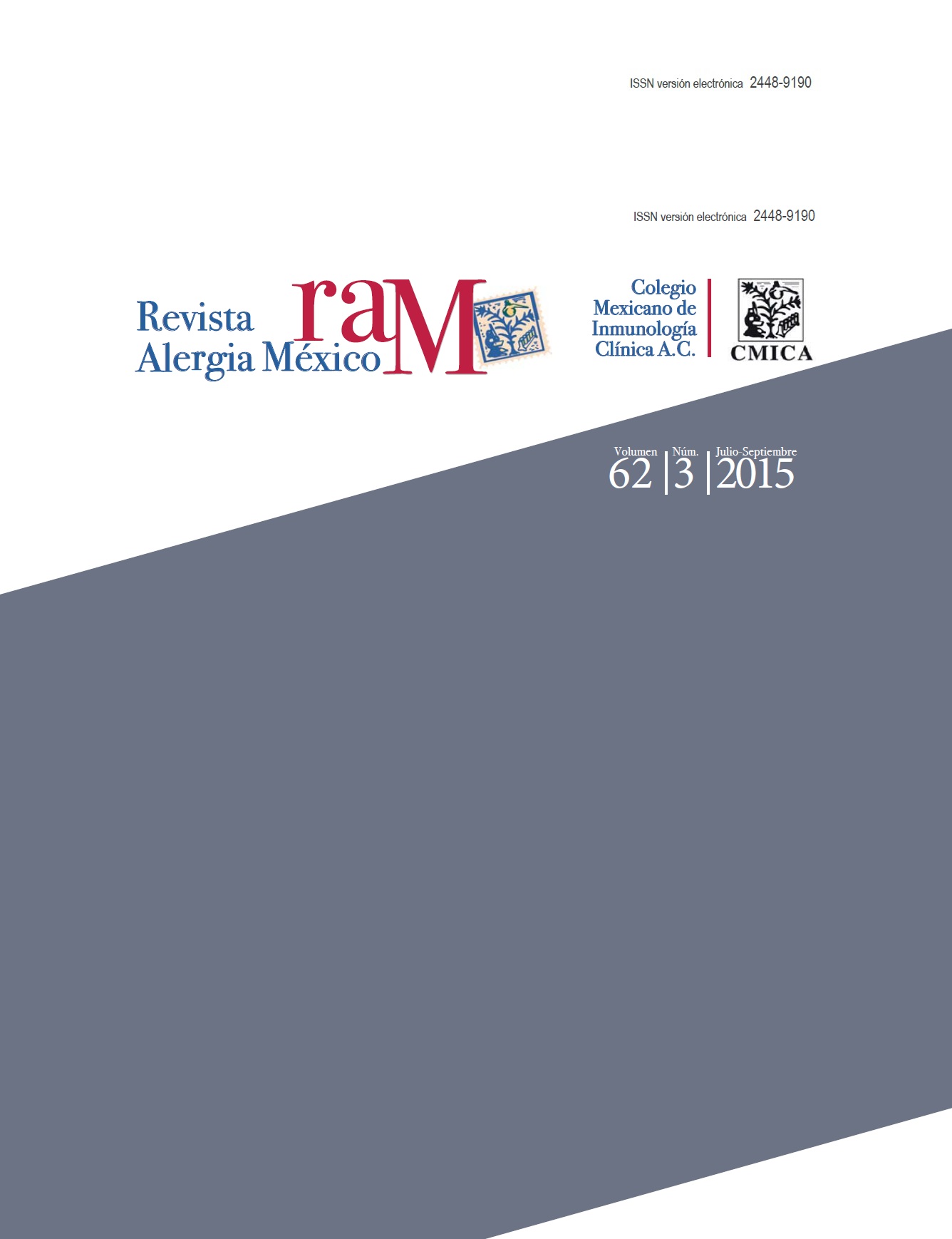Resumen
Antecedentes: si bien se cuenta con información epidemiológica de las inmunodeficiencias primarias, la información disponible en México es escasa.
Objetivos: dar información epidemiológica del retraso del diagnóstico de las inmunodeficiencias primarias y de su correlación con daño pulmonar crónico.
Material y método: estudio retrospectivo, analítico, efectuado en pacientes de 0 a 18 años de edad con diagnóstico de inmunodeficiencias primarias durante 11 años en el Hospital Infantil de México Federico Gómez; las variables estudiadas fueron: edad al inicio de los síntomas, edad al diagnóstico, tiempo desde el inicio de los síntomas al diagnóstico, número de neumonías previas y estudios radiográficos con datos de daño pulmonar crónico.
Resultados: se incluyeron 48 pacientes que cumplieron los criterios de inclusión; 33 tenían daño pulmonar al diagnóstico, el déficit de anticuerpos fue el grupo con mayor afectación. Al correlacionar la edad de inicio de los síntomas y la diferencia de tiempo del inicio de los síntomas al diagnóstico se obtuvo una fuerte correlación (p <0.001, Rho > 0.80). Se observó una correlación moderada entre la diferencia en tiempo vs número de neumonías (p=0.005, Rho=0.495) y la correlación entre número de neumonías y daño pulmonar mostró significación alta (p <0.001, Rho=0.704).
Conclusión: se encontró una relación estrecha entre el tiempo transcurrido desde el inicio de los síntomas y el número de neumonías con el daño pulmonar, por lo que las neumonías de repetición (más de dos) deben hacer sospechar el diagnóstico de inmunodeficiencia primaria, como se recomienda en la bibliografía mundial.
Referencias
Bonilla, F.A., et al., Practice parameter for the diagnosis and management of primary immunodeficiency. Ann Allergy Asthma Immunol, 2005. 94(5 Suppl 1): p. S1-63.
Casanova, J.L., et al., Revisiting human primary immunodeficiencies. J Intern Med, 2008. 264(2): p. 115-27.
Notarangelo, L.D., Primary immunodeficiencies. J Allergy Clin Immunol, 2010. 125(2 Suppl 2): p. S182-94.
Azarsiz, E., et al., Consanguinity rate and delay in diagnosis in Turkish patients with combined immunodeficiencies: a single-center study. J Clin Immunol, 2011. 31(1): p. 106-11.
Ballow, M., et al., Immunodeficiencies. Clin Exp Immunol, 2009. 158 Suppl 1: p. 14-22.
Barbouche, M.R., et al., Primary immunodeficiencies in highly consanguineous North African populations. Ann N Y Acad Sci, 2011. 1238: p. 42-52.
Sanal, O. and I. Tezcan, Thirty years of primary immunodeficiencies in Turkey. Ann N Y Acad Sci, 2011. 1238: p. 15-23.
Martin-Nalda, A., et al., [Spectrum of primary immunodeficiencies in a tertiary hospital over a period of 10 years]. An Pediatr (Barc), 2011. 74(2): p. 74-83.
Modell, V., et al., Global study of primary immunodeficiency diseases (PI)--diagnosis, treatment, and economic impact: an updated report from the Jeffrey Modell Foundation. Immunol Res, 2011. 51(1): p. 61-70.
Condino-Neto, A., et al., Critical issues and needs in management of primary immunodeficiency diseases in Latin America. Allergol Immunopathol (Madr), 2011. 39(1): p. 45-51.
Etzioni, A. and R. Sorensen, [Early Diagnosis and Adequate Treatment- for Improving and Saving the life of Patients with Primary Immunodeficiencies]. Rev Alerg Mex, 2012. 59(1): p. 1-2.
Condino-Neto, A., et al., Advancing the management of primary immunodeficiency diseases in Latin America: Latin American Society for Immunodeficiencies (LASID) Initiatives. Allergol Immunopathol (Madr), 2012. 40(3): p. 187-93.
Group of Pediatric, I., et al., Comment on: advances in primary immunodeficiency diseases in Latin America: epidemiology, research, and perspectives. Ann. N.Y. Acad. Sci. 1250: 62-72 (2012). Ann N Y Acad Sci, 2013. 1306: p. 71-2.
Leiva, L.E., et al., Primary immunodeficiency diseases in Latin America: proceedings of the Second Latin American Society for Immunodeficiencies (LASID) Advisory Board. Allergol Immunopathol (Madr), 2011. 39(2): p. 106-10.
Leiva, L.E., et al., Primary immunodeficiency diseases in Latin America: the second report of the LAGID registry. J Clin Immunol, 2007. 27(1): p. 101-8.
Zelazko, M., et al., Primary immunodeficiency diseases in Latin America: first report from eight countries participating in the LAGID. Latin American Group for Primary Immunodeficiency Diseases. J Clin Immunol, 1998. 18(2): p. 161-6.
Cunningham-Rundles, C., Lung disease, antibodies and other unresolved issues in immune globulin therapy for antibody deficiency. Clin Exp Immunol, 2009. 157 Suppl 1: p. 12-6.
Cantani, A. and M. Ferrara, The lung and primary immunodeficiency. Allergol Immunopathol (Madr), 1988. 16(6): p. 429-37.
Dukes, R.J., E.C. Rosenow, 3rd, and P.E. Hermans, Pulmonary manifestations of hypogammaglobulinaemia. Thorax, 1978. 33(5): p. 603-7.
Sweinberg, S.K., et al., Retrospective analysis of the incidence of pulmonary disease in hypogammaglobulinemia. J Allergy Clin Immunol, 1991. 88(1): p. 96-104.
Watts, W.J., et al., Respiratory dysfunction in patients with common variable hypogammaglobulinemia. Am Rev Respir Dis, 1986. 134(4): p. 699-703.
Sorensen, R., et al., Collaborating to improve quality of life in primary immunodeficiencies: World PI Week, 2013. J Clin Immunol, 2013. 33(7): p. 1145-8.
Al-Herz, W., et al., Primary immunodeficiency diseases: an update on the classification from the international union of immunological societies expert committee for primary immunodeficiency. Front Immunol, 2011. 2: p. 54.
Jeffrey Modell Foundation (2014) Disponible en: http://www.info4pi.org/library/educational-materials/10-warning-signs
O'Sullivan, M.D. and A.J. Cant, The 10 warning signs: a time for a change? Curr Opin Allergy Clin Immunol, 2012. 12(6): p. 588-94.

Esta obra está bajo una licencia internacional Creative Commons Atribución-NoComercial 4.0.
Derechos de autor 2015 Revista Alergia México





